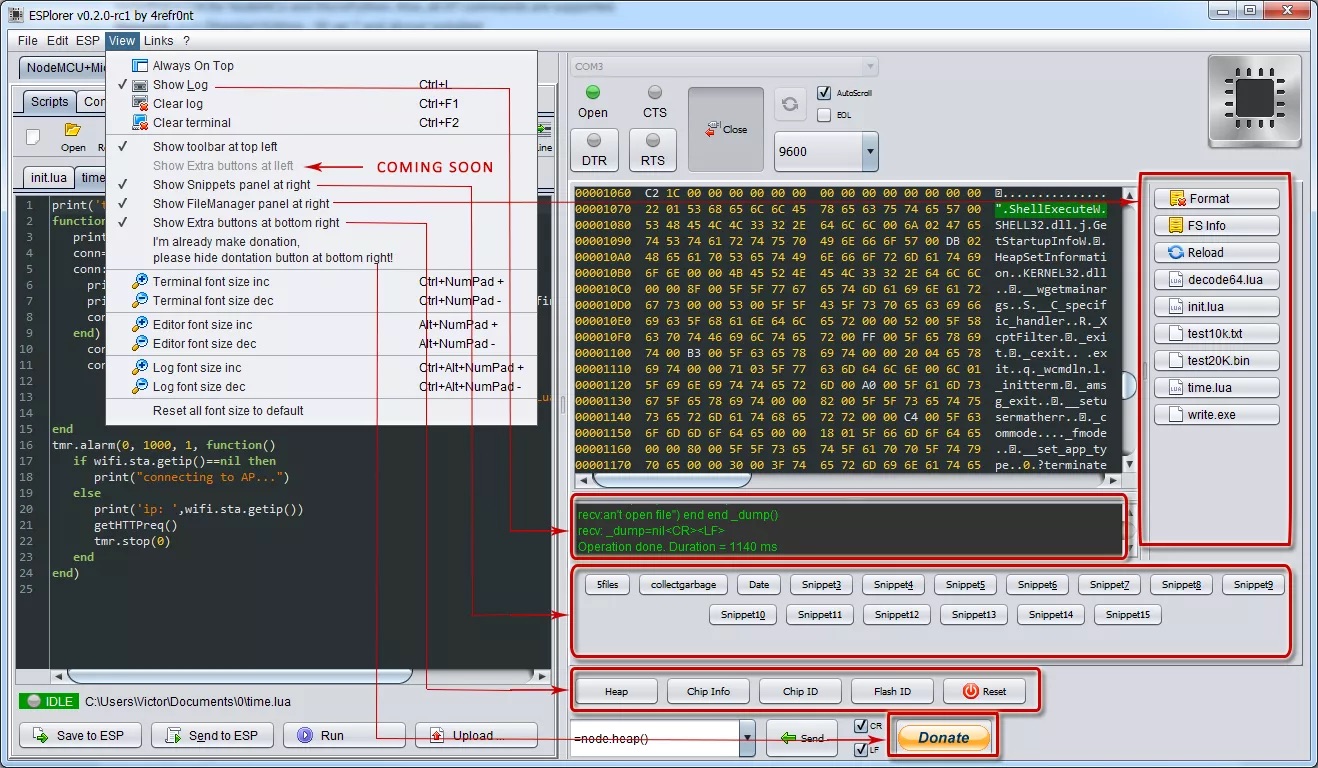As with flashing there are several ways to upload code from your computer to the device.
Note that the NodeMCU serial interface uses 115200bps at boot time. To change the speed after booting, issue uart.setup(0,9600,8,0,1,1). ESPlorer will do this automatically when changing the speed in the dropdown list. If the device panics and resets at any time, errors will be written to the serial interface at 115200 bps.
Tools¶
Transferring application code to ESP32 is an essential task, one that you'll perform quite frequently. Hence, it does make sense to try a few different uploading tools until you find one you feel comfortable with. https://frightanic.com/iot/tools-ides-nodemcu/ lists almost a dozen classical uploaders - in addition to IDEs or IDE-like applications which of course transfer code as well.
Note
Most of the listed tools and IDEs target the ESP8266 and might also work for the ESP32-based firmware. Be prepared to encounter random issues for tools that do not claim to support the ESP32 Lua in their feature list.
The NodeMCU firmware team does not give any recommendations as for which uploader to use nor are there any "NodeMCU approved" tools. The below listed tools are just three, in no particular order, which seem popular and/or reasonably well maintained.
ESPlorer¶
The essential multiplatforms tools for any ESP8266 developer from luatool author’s, including Lua for NodeMCU and MicroPython. Also, all AT commands are supported. Requires Java (Standard Edition - SE ver 7 and above) installed.

Source: https://github.com/4refr0nt/ESPlorer
Supported platforms: OS X, Linux, Windows, anything that runs Java
ChiliPeppr ESP32 Web IDE¶
This is a new method via the browser of editing/uploading your Lua code to your ESP32 devices. The workspace has a Serial Port JSON Server that you run locally or remotely on your computer to let your browser talk direct to your serial ports. The Ace editor is embedded which does code highlighting and intellisense for Lua. There is a file browser for your ESP32, a serial port console, restart button, file saving, run, upload/run, and upload all. [...] There is also an XBM image creator for OLED displays that let you cut/paste PNG, JPEG, or GIF images or even drag/drop of animated GIFs to create Lua code.

Source: https://github.com/chilipeppr/workspace-esp32-lua
Supported platforms: OS X, Linux, Windows
Location: http://chilipeppr.com/esp32
Compiling Lua on your PC for Uploading¶
If you install lua on your development PC or Laptop then you can use the standard Lua compiler to syntax check any Lua source before downloading it to the ESP32 module. However, the nodemcu compiler output uses different data types (e.g. it supports ROMtables) so the compiled output cannot run on the ESP32.
Compiling source on one platform for use on another (e.g. Intel x38 Window to ESP32) is
known as cross-compilation and the nodemcu firmware supports the compilation of luac.cross
on *nix patforms which have Lua 5.1, the Lua filesystem module (lfs), and the essential
GCC tools. Simply change directory to the firmware root directoy and run the command:
lua tools/cross-lua.lua
This will generate a luac.cross executable in your root directory which can be used to
compile and to syntax-check Lua source on the Development machine for execution under
nodemcu lua on the ESP32.